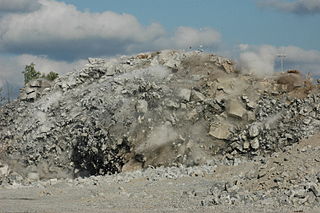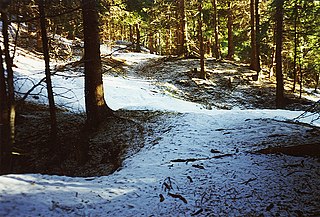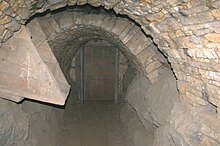
Mining is the extraction of valuable geological materials from the Earth and other astronomical objects. Mining is required to obtain most materials that cannot be grown through agricultural processes, or feasibly created artificially in a laboratory or factory. Ores recovered by mining include metals, coal, oil shale, gemstones, limestone, chalk, dimension stone, rock salt, potash, gravel, and clay. The ore must be a rock or mineral that contains valuable constituent, can be extracted or mined and sold for profit. Mining in a wider sense includes extraction of any non-renewable resource such as petroleum, natural gas, or even water.

A gunnies, gunnis, or gunniss is the space left in a mine after the extraction by stoping of a vertical or near vertical ore-bearing lode. The term is also used when this space breaks the surface of the ground, but it can then be known as a coffin or goffen. It can also be used to describe the deep trenches that were dug by early miners in following the ore-bearing lode downwards from the surface – in this case they are often called open-works; their existence can provide the earliest evidence of mining in an area. William Pryce, writing in 1778, also used the term as a measure of width, a single gunnies being equal to three feet.

Open-pit mining, also known as open-cast or open-cut mining and in larger contexts mega-mining, is a surface mining technique of extracting rock or minerals from the earth from an open-air pit, sometimes known as a borrow.

Shaft mining or shaft sinking is the action of excavating a mine shaft from the top down, where there is initially no access to the bottom. Shallow shafts, typically sunk for civil engineering projects, differ greatly in execution method from deep shafts, typically sunk for mining projects.

Drilling and blasting is the controlled use of explosives and other methods, such as gas pressure blasting pyrotechnics, to break rock for excavation. It is practiced most often in mining, quarrying and civil engineering such as dam, tunnel or road construction. The result of rock blasting is often known as a rock cut.

Harmony Gold is the largest gold mining company in South Africa. Harmony operates in South Africa and in Papua New Guinea. The company has nine underground mines, one open-pit mine and several surface operations in South Africa. In Papua New Guinea, it has Hidden Valley, an open-pit gold and silver mine and a 50% interest in the Morobe Mining Joint Venture, which includes the Wafi-Golpu project and extensive exploration tenements. Outside the joint venture, Harmony's own exploration portfolio focuses principally on highly prospective areas in Papua New Guinea.
A raise borer is a machine used in underground mining, to excavate a circular hole between two levels of a mine without the use of explosives.

Mine exploration is a hobby in which people visit abandoned mines, quarries, and sometimes operational mines. Enthusiasts usually engage in such activities for the purpose of exploration and documentation, sometimes through the use of surveying and photography. In this respect, mine exploration might be considered a type of amateur industrial archaeology. In many ways, however, it is closer to caving, with many participants actively interested in exploring both mines and caves. Mine exploration typically requires equipment such as helmets, head lamps, Wellington boots, and climbing gear.

The Challenger mine is a gold mine in the Far North of South Australia, 165 km west of the Stuart Highway and 740 km north-west of Adelaide. It was operated by Dominion, Kingsgate and then WPG Resources. The mine is now on Care and Maintenance. The deposit was named by the geologist who discovered it, after his dog.

Creighton Mine is an underground nickel, copper, and platinum-group elements (PGE) mine. It is presently owned and operated by Vale Limited in the city of Greater Sudbury, Ontario, Canada. Open pit mining began in 1901, and underground mining began in 1906. The mine is situated in the Sudbury Igneous Complex (SIC) in its South Range geologic unit. The mine is the source of many excavation-related seismic events, such as earthquakes and rock burst events. It is home to SNOLAB, and is currently the deepest nickel mine in Canada. Expansion projects to deepen the Creighton Mine are currently underway.

The following outline is provided as an overview of and topical guide to mining:

Stoping is the process of extracting the desired ore or other mineral from an underground mine, leaving behind an open space known as a stope. Stoping is used when the country rock is sufficiently strong not to collapse into the stope, although in most cases artificial support is also provided.

Boring is drilling a hole, tunnel, or well in the Earth. It is used for various applications in geology, agriculture, hydrology, civil engineering, and mineral exploration. Today, most Earth drilling serves one of the following purposes:

Mining in the Upper Harz region of central Germany was a major industry for several centuries, especially for the production of silver, lead, copper, and, latterly, zinc as well. Great wealth was accumulated from the mining of silver from the 16th to the 19th centuries, as well as from important technical inventions. The centre of the mining industry was the group of seven Upper Harz mining towns of Clausthal, Zellerfeld, Sankt Andreasberg, Wildemann, Grund, Lautenthal und Altenau.

The Kemi Mine is owned by Outokumpu Chrome Oy, a subsidiary of Outokumpu Oyj. It is located in Elijärvi, in the municipality of Keminmaa, to the north of Kemi. The Kemi Mine is the largest underground mine in Finland, with an annual production capacity of 2.7 million tonnes of ore. It is also part of the integrated ferrochrome and stainless steel manufacturing chain owned by Outokumpu in the Kemi-Tornio region. The Kemi Mine has approximately 400 employees every day, both employees of Outokumpu and contractors.
Steep Rock Lake is a body of water near the township of Atikokan, northern Ontario, Canada. It was originally fed by the Seine River.

A Pinge or Binge ("binger") is the name given in German-speaking Europe to a wedge-, ditch- or funnel-shaped depression in the terrain caused by mining activity. This depression or sink-hole is frequently caused by the collapse of old underground mine workings that are close to the Earth's surface. Unlike natural landforms, a Pinge is a direct result of human activity. The term has no direct equivalent in English, but may be translated as "mining sink-hole", "mine slump" or, in some cases, as "glory hole".

LHD loaders are similar to conventional front end loaders but developed for the toughest of hard rock mining applications, keeping overall production economy, safety, and reliability in consideration. They are extremely rugged, highly maneuverable, and exceptionally productive. More than 75% of the world's underground metal mines use LHD for handling the muck of their excavations.
Deep level underground is construction that is 20 m (66 ft) or more below ground and not using the cut-and-cover method, especially train stations, air raid shelters and bunkers, and some tunnels and mines. Cut-and-cover is a simple method of construction for shallow tunnels where a trench is excavated and roofed over with an overhead support structure that is strong enough to carry the load of what is to be built above the tunnel.
The Rajpura Dariba Mine VRM disaster took place in Dariba, Udaipur, India on 28 August 1994 at a mine operated by Hindustan Zinc Ltd.




















